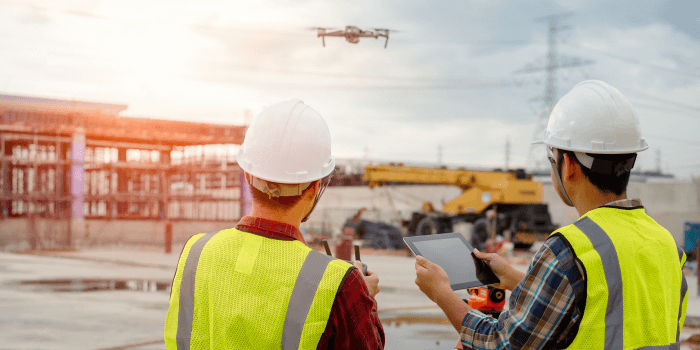Have you thought about investing in drone technology to survey land, manage safety or inspect more efficiently? There are a lot of ways that investing in drones can help your construction business!
- Save time and manpower surveying land
- Maintain safety and security of the construction site
- Ensure quality inspection
- Allow for remote monitoring of job site
Drones in Construction, how can they help?
Drones have been introduced to the sites of many renowned construction businesses. There are some advantages of drones that can help your business in many ways.

Land Surveying: Surveying the land is a tedious task that might take up a lot of time and energy. Drones can help in simplifying the process by giving up-front information about the site with detailed imagery. The information that usually takes weeks to find is now available within days and the chances of human error are reduced. Using a drone for surveying also brings down the cost required for aerial photography that is historically been done using an aircraft.
Surveillance: As a business owner you may not have the time to surveillance the whole job site as much as you need to. A construction business loses money every year on the theft or misplacement of raw materials and construction equipment. Drones can create a monitoring system that increases safety and controls theft. The FAA (Federal Aviation Administration) has stringent rules on drone usage for commercial purpose. Most drone models used by construction businesses come under 4.4 pounds weight threshold and 400-foot travel radius category. Drones in this class do not experience such strict rules, allowing you to use it for surveillance.
Transportation: Drones are small, light-weight and are easy to maneuver, making them ideal for transportation of materials in your construction site. The drones also take only a fraction of the cost and effort, compared to the traditional material delivery methods. It is a stretch to say that drones can deliver heavy construction materials from storage to the construction site, but it can help with moving small materials on site.
Building Information Modelling (BIM): Building Information Modelling is the process of collecting information throughout the life-cycle of a project, and creating multi-dimensional models of buildings. You or your project manager can update each phase of the project, digitally. Drones can help in this by progress monitoring and creating orthomosaics.
Communication and Management: If you have multiple projects to manage at the same time, it is difficult to be physically present in each of them to get updates. Drones give you connectivity with your construction sites and get real-time updates. Keeping tab on workers through a mounted-camera on your drones has proven to be increasingly helpful for engineers and supervisors.
Marketing Collateral: Marketing your construction project or your business is as important as any other business activity that you do. Drones give you an edge over your competitors by taking excellent aerial shots of your site. For example, you can have a time-lapse video from the construction mapping to the project completion stage to show your customer what you can provide.
Implementing Drone Programs in your Business
Drones appear to soon be heavily involved in the day to day construction workflow. There are two ways in which you can use drones for your business.
In-house Drone Program: If you have multiple projects lined up and require full-time drones, it is better to buy your own. The initial costs of owning a fleet of drones might be manageable. However, you also have to factor in the costs of accessories, maintenance, replacement and training. If you know this would benefit your business, use construction business funding to get capital to cover this investment.
Outsourced Drone Program: If you are a small business that does not have a full-time requirement of drones or if you are still testing the waters of this new technology, this program is for you. You don’t have to train a person from your team to operate the drone as it comes with an operator as a part of the service. There are many companies that can do this for you but, in the long run, it may end up being more expensive. Do plenty of research before making your final decision.
Did you know?
A survey states, the commercial drone industry will reach $5 billion by 2020 and it will replace $127.3 Billion in labor value and service provided by all industries. The construction industry is among the largest in the world with $1,231 billion U.S dollars expenditure. The challenges faced by this business cause project delays and overhead expenses. Drones and the technology supporting it can help with reducing many of these challenges.






